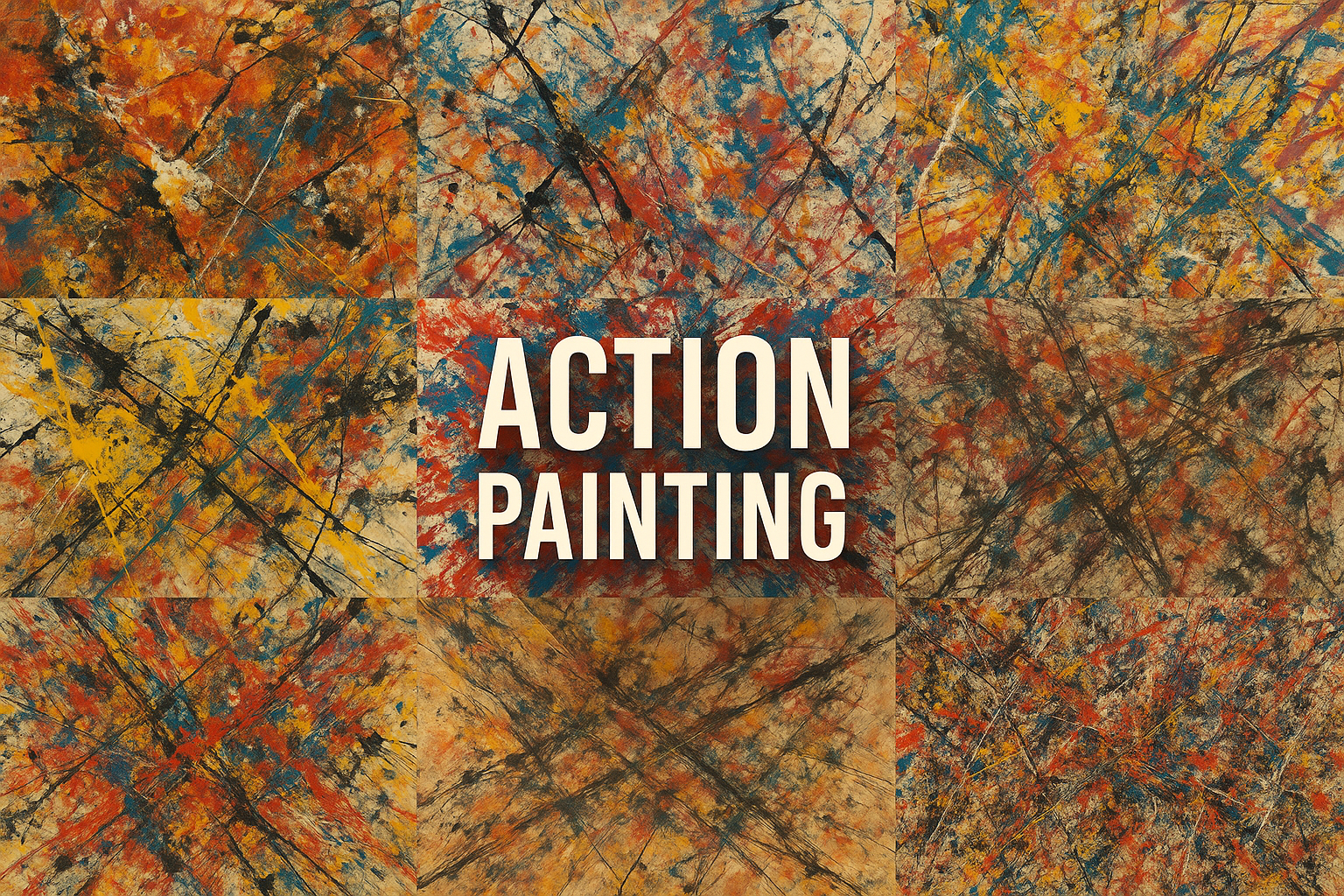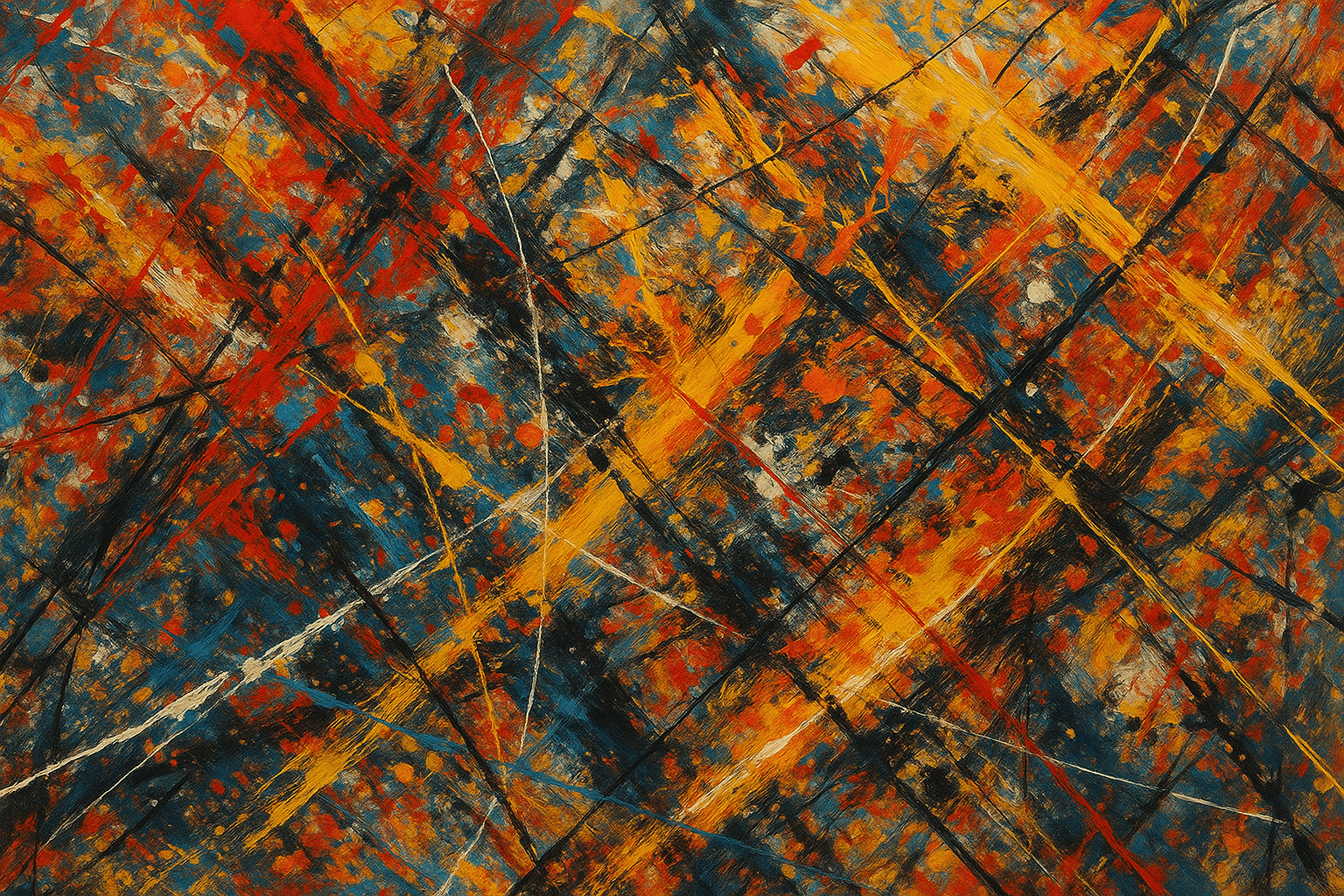
Action painting
Action painting is a type of painting in which the artist uses quick, spontaneous brushstrokes to capture the essence of an object or scene. The resulting work is often highly expressive and emotive.
AOI thinking about Action painting [+_~]-/
Overview and Quickfacts
Action painting is a style of painting in which the artist uses quick, spontaneous strokes to apply paint to the canvas. This technique often results in bold and expressive works of art.
Can understand it also, as:
Abstract expressionism, gestural abstraction, post-painterly abstraction, color field painting, lyrical abstraction, hard-edge painting, neo-expressionism, postmodernism, stenciling
Categorize it as:
Impressionism, Modernism
.: Dreaming :.
holds a HAIKU for the art style
:. Thought is power .:
Detailed Description
Action painting is a style of painting in which the artist uses quick, spontaneous strokes to apply paint to the canvas. This technique often results in bold and expressive works of art. One of the most famous action painters is Jackson Pollock. Pollock is known for his “drip paintings,” in which he would pour paint onto the canvas and then manipulate it with his hands or other tools. These paintings are often characterized by their chaotic and energetic appearance. Other well-known action painters include Willem de Kooning and Franz Kline. These artists also used bold and expressive brushstrokes in their paintings. Action painting can be seen as a reaction against more traditional styles of painting. In action painting, the artist is more concerned with the process of creating the painting, rather than the final product. This approach to painting often results in works that are highly expressive and unique.
.. beep, beep, beep ..
<START OF TRANSMISSION>
1. Action painting is a type of painting in which the artist uses quick, spontaneous brushstrokes to capture the essence of an object or scene. 2. Action painting is often associated with Abstract Expressionism, as both movements emphasize the artist's process and the act of painting itself. 3. Action painting can be traced back to the early 20th century, when artists such as Wassily Kandinsky and Franz Marc began experimenting with expressive, gestural brushwork. 4. Jackson Pollock is perhaps the most famous action painter, known for his "drip" paintings in which he would pour and splatter paint onto canvas. 5. Pollock's approach to painting was highly influential, and helped to pave the way for the Abstract Expressionist movement. 6. Other notable action painters include Willem de Kooning, Mark Rothko, and Barnett Newman. 7. Action painting often makes use of non-traditional painting techniques, such as dripping, pouring, splattering, and staining. 8. These techniques can produce highly textured and dynamic results. 9. Action painting often relies on the element of chance, as the artist allows the paint to flow and interact in unpredictable ways. 10. The resulting paintings are often highly intuitive and expressive, reflecting the artist's inner thoughts and emotions. 11. Action painting can be an extremely physical process, as the artist often works with their hands and body to apply the paint. 12. This can result in a highly energetic and gestural style of painting. 13. Action painting often involves working on a large scale, as the artist needs to be able to move around freely and make bold brushstrokes. 14. The paintings can be highly improvisational, and the artist may start with no specific plan or idea in mind. 15. The process of action painting can be extremely cathartic and therapeutic for the artist. 16. The paintings often have a raw and primal quality, reflecting the artist's subconscious mind. 17. Action painting can be seen as a form of automatic writing, as the artist allows their subconscious to guide their brushstrokes. 18. The paintings often have a dreamlike quality, and can be interpreted in many ways. 19. Action painting can be a very intuitive and personal process, as the artist is often working without any preconceived notions or ideas. 20. The resulting paintings are often highly individual and unique, reflecting the artist's own inner thoughts and feelings.
<EOF>
.. robbel bob
Visual Examples from our image gallery
Coming soon, we are so slow .. might never come
Artists, Paintings, and more
(be aware, can be highly speculative)
Artists (be aware, speculation possible):
1. Jackson Pollock (1912-1956) 2. Willem de Kooning (1904-1997) 3. Franz Kline (1910-1962) 4. Robert Motherwell (1915-1991) 5. Barnett Newman (1905-1970) 6. Clyfford Still (1904-1980) 7. Mark Rothko (1903-1970) 8. Adolph Gottlieb (1903-1974) 9. Hans Hofmann (1880-1966) 10. Arshile Gorky (1904-1948) 11. David Smith (1906-1965) 12. Richard Diebenkorn (1922-1993) 13. Helen Frankenthaler (1928-2011) 14. Robert Rauschenberg (1925-2008) 15. Jasper Johns (1930-) 16. Lee Krasner (1908-1984) 17. Elaine de Kooning (1918-1989) 18. Philip Guston (1913-1980) 19. Alex Katz (1927-) 20. Edward Hopper (1882-1967) 21. Georgia O’Keeffe (1887-1986) 22. Andrew Wyeth (1917-2009) 23. John Singer Sargent (1856-1925) 24. Mary Cassatt (1844-1926) 25. Winslow Homer (1836-1910) 26. Claude Monet (1840-1926) 27. Pierre-Auguste Renoir (1841-1919) 28. Paul CÃÂézanne (1839-1906) 29. Vincent van Gogh (1853-1890) 30. Rembrandt (1606-1669)
Artworks (be aware, speculation possible)
1. “Autumn Rhythm” by Jackson Pollock (1950) 2. “Black and White” by Willem de Kooning (1948) 3. “Blue Poles” by Jackson Pollock (1952) 4. “Drip Painting” by Jackson Pollock (1946) 5. “Elegant Lady” by Willem de Kooning (1952) 6. “Excavation” by Willem de Kooning (1950) 7. “Guggenheim Museum” by Jackson Pollock (1956) 8. “Hans Hofmann” by Willem de Kooning (1955) 9. “Interchange” by Willem de Kooning (1955) 10. “Number 1” by Jackson Pollock (1948) 11. “Number 10” by Jackson Pollock (1949) 12. “Number 11” by Jackson Pollock (1949) 13. “Number 12” by Jackson Pollock (1950) 14. “Number 14” by Jackson Pollock (1950) 15. “Number 17A” by Jackson Pollock (1948) 16. “Number 18” by Jackson Pollock (1951) 17. “Number 19” by Jackson Pollock (1951) 18. “Number 20” by Jackson Pollock (1951) 19. “Number 22” by Jackson Pollock (1952) 20. “Number 23” by Jackson Pollock (1952) 21. “Number 25” by Jackson Pollock (1953) 22. “Number 27” by Jackson Pollock (1953) 23. “One” by Jackson Pollock (1948) 24. “Painting” by Jackson Pollock (1946) 25. “Pink Angels” by Jackson Pollock (1945) 26. “Portrait and a Dream” by Jackson Pollock (1953) 27. “Sea Change” by Jackson Pollock (1947) 28. “Shimmering Substance” by Jackson Pollock (1946) 29. “The Key” by Jackson Pollock (1946) 30. “Untitled” by Jackson Pollock (1952)
Epoch
The art style Action painting emerged in the 1940s.
AI ART RESSOURCES (AKA, well Tools)
Helping tools -> predefined search links on other pages:











